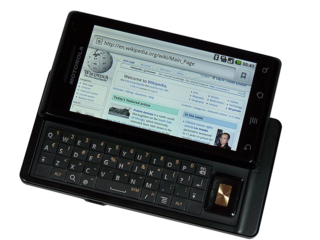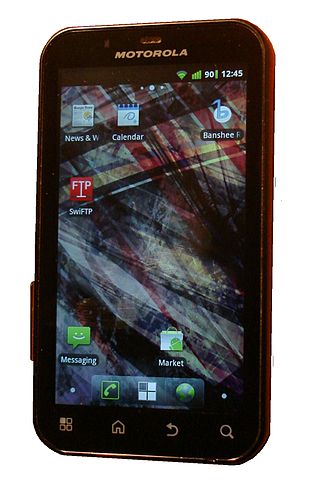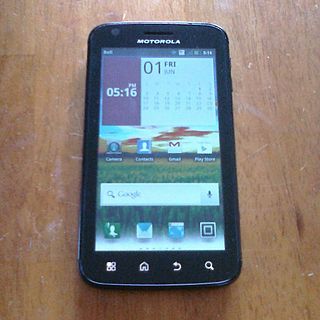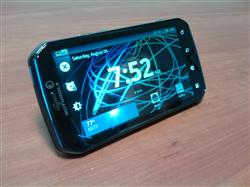
The OMAP family, developed by Texas Instruments, was a series of image/video processors. They are proprietary system on chips (SoCs) for portable and mobile multimedia applications. OMAP devices generally include a general-purpose ARM architecture processor core plus one or more specialized co-processors. Earlier OMAP variants commonly featured a variant of the Texas Instruments TMS320 series digital signal processor.
Motorola Mobility LLC, marketed as Motorola, is an American consumer electronics manufacturer primarily producing smartphones and other mobile devices running Android. It is a subsidiary of the Chinese multinational technology company Lenovo.

The Motorola Droid is an Internet and multimedia-enabled smartphone designed by Motorola, which runs Google's Android operating system. The Droid had been publicized under the codenames Sholes and Tao and the model number A855. In Latin America and Europe, the model number is A853 (Milestone), and in Mexico, the model number is A854 (Motoroi). Due to the ambiguity with newer phones with similar names, it is also commonly known as the DROID 1. The brand name Droid is a trademark of Lucasfilm licensed to Verizon Wireless.
The Motorola Calgary is an Android-based smartphone by Motorola to be initially distributed by Verizon Wireless in the United States. Features of the phone include Wi-Fi networking, a 3-megapixel low light capable digital camera, a standard 3.5 mm headphone jack, interchangeable battery, 3.2-inch touchscreen, MicroSDHC support, QWERTY keyboard, and Texas Instruments OMAP 3430 processor. The Motorola Calgary runs version 1.6, codenamed doughnut, of Google's Android operating system. The phone does, however, run the re-branded MOTOBLUR version of Android, instead of providing the Google Experience skin and application stack. The phone could possibly be a more affordable alternative to the Motorola Droid. Recent photos have leaked, having the phone differ largely form the original render, now seen in the colors black and silver, still running MOTOBlur. It is also assumed that Verizon will release it under the name DROID Devour, as their current Android device naming is out into place.

The Motorola Droid 2 is the fifth phone in Verizon's Droid line. In the U.S., it is available exclusively on Verizon Wireless, and was released August 12, 2010. It runs the Android operating system by Google, and can run Flash Player 10.1. It comes with 8 GB of internal memory and is shipped with an additional 8 GB SDHC card, upgradable to 32 GB. It has a 3.7 in display and a 5-megapixel camera. Unlike the Droid X, the Motorola Droid 2 features a redesigned slide-out QWERTY keyboard, but still features the Swype keyboard found on the Droid X. A limited edition version featuring the Star Wars droid character R2-D2 with exclusive apps and content was announced by Verizon for September 30, 2010, to commemorate the thirtieth anniversary for The Empire Strikes Back.
Google Nexus is a discontinued line of consumer electronic devices that run the Android operating system. Google managed the design, development, marketing, and support of these devices, but some development and all manufacturing were carried out by partnering with original equipment manufacturers (OEMs). Alongside the main smartphone products, the line also included tablet computers and streaming media players; the Nexus started out in January 2010 and reached its end in October 2016, replaced by Google Pixel.

The Motorola Defy (A8210/MB525) is an Android-based smartphone from Motorola. It filled a niche market segment, by being one of the few small, IP67 rated smartphones available at the time of its late 2010 release. It is water resistant, dust resistant, and has an impact-resistant screen. The phone was launched unlocked in Germany, France, Italy, Hungary, India, Thailand, Spain, the UK, Turkey, Romania and Greece under various networks and was distributed exclusively by a number of carriers, including T-Mobile in the United States, Telus in Canada, and Telstra and Optus in Australia. An updated version of the original MB525, Defy+ (MB526) is also available.

The Motorola Atrix 4G is an Android-based smartphone developed by Motorola, introduced at CES 2011 along with the Motorola Xoom, Motorola Droid Bionic, and Motorola Cliq 2 on January 5, 2011. It was made available in the first quarter of 2011.

The Motorola Droid Bionic is an Android-based, 4G LTE-capable smartphone designed by Motorola. It was originally scheduled for release in Q2 2011 but was delayed, eventually being released on 8 September 2011.

The Motorola Milestone XT720 is an Android-based smartphone manufactured by Motorola Mobility, originally released in July 2010. Announced in June of that year, it was the first Motorola Android phone with xenon flash.

The Motorola DROID 3 is a smartphone released on July 7, 2011, by Verizon Wireless running the Android 2.3 operating system by Google. It comes with 16 GB of internal storage. The smartphone does not ship with a microSD card. It has a 4-inch qHD display and an 8-megapixel camera capable of recording 1080p video. Unlike the DROID 2, the Motorola DROID 3 features a 5-row QWERTY keyboard, with a dedicated number row. It also has a VGA front-facing camera for video calls. The Droid 3 ships with Android 2.3.4 (Gingerbread) with Motorola's updated proprietary Motoblur UI. Like other contemporary Motorola phones, it has a locked bootloader, but it can have a custom rom using SafeStrap.

The Motorola Photon 4G was a high end Android-based mobile smartphone that was distributed exclusively by Sprint. A very similar model was available as the Motorola Electrify from U.S. Cellular.

The Verizon Droid Razr is an Android-based, 4G LTE-capable smartphone designed by Motorola that launched on Verizon Wireless on November 11, 2011. It was announced on October 18, 2011 in New York City.

Lenovo smartphones are marketed as the "LePhone" in Mainland China and the "IdeaPhone" overseas. Motorola Mobility, ZUK Mobile and Medion, divisions of Lenovo, sell smartphones under their own brands. As of September 2015, Lenovo is in the process of rebranding most of its phones using the Motorola brand name.

The Motorola Droid 4 (XT894) is a smartphone made by Motorola Mobility. It was released with Android 2.3 and can be upgraded to Android 4.1. It was released on Verizon Wireless's network on February 10, 2012. It is the successor to Motorola's Droid 3, and is one of the first smartphones to support GLONASS in addition to GPS.

The Droid Razr M is an Android-based, 4G LTE-capable smartphone designed by Motorola as a smaller successor to the Droid Razr. It was advertised as "The full screen phone" with thin edges, though it lacked a robust resolution. It came with a light skin of Android for Verizon Wireless (XT907), SoftBank Mobile (XT902), and Telstra as well as an unbranded retail version for the Australian market. The Electrify M (XT901) for U.S. Cellular is a CDMA handheld with a different housing, but otherwise same specification as the Razr M.

The Droid Razr HD and Droid Razr Maxx HD are Android-based, 4G LTE-capable smartphones designed by Motorola as the successor to the Droid Razr series released nearly a year prior. Notable changes from their predecessors include 720p resolution displays and increased display size while maintaining similar overall dimensions. Additionally, the battery capacity on the standard Razr HD is 42% larger than its predecessor. Both go by the model number XT926. These phones were released on October 18, 2012 exclusively on Verizon Wireless in the United States. The Motorola Razr HD were available as international or global phones in Europe, Latin America, Australia and Canada as early as October 2, 2012. In the summer of 2013, storyboards surfaced of television commercials that have not yet aired. These commercials will feature the Droid Maxx and Droid Ultra, the apparent successors to the Droid Razr Maxx HD and Droid Razr HD, respectively.
The Droid Maxx is a smartphone developed by Motorola Mobility. It is the first Droid to be a high end smartphone exclusively developed by Motorola for Verizon Wireless. It is part of the Verizon Droid line, and was announced on 23 July 2013 along with the Droid Ultra and Droid Mini at a joint Motorola and Verizon Wireless press conference.

The Droid Turbo is a high end smartphone developed by Motorola Mobility. It is part of the Verizon Droid line, and was announced on October 28, 2014 on the Verizon Droid Does website. The Droid Turbo maintains a similar design shape to its predecessor, the Droid Maxx, with new durable ballistic nylon or metallized glass fiber reinforced with Kevlar as the materials offered. The on-screen buttons for back, home, and multitask functions were kept off-screen as capacitive soft-keys below the display. Due to Lenovo closing its acquisition of Motorola Mobility from Google, the Droid Turbo was the first phone released by Motorola Mobility under Lenovo ownership, as it was released through Verizon Wireless first on the same day the Lenovo sale closed, October 30, 2014.

Moto X Play is an Android smartphone developed by Motorola Mobility, a subsidiary of Lenovo. Unveiled on July 28, 2015, it was one of three devices that succeeded the second-generation Moto X. In contrast to the high-end Moto X Style, the Play is a mid-range device distinguished by its high battery capacity.

















